Some structures in the world are outstandingly magnificent. They leave visitors wonderstruck and are therefore, known as “Wonders of the World.” These structures remind us of our past, as well as the natural world around us.
In ancient times, these magnificent structures were built using simple techniques and machines. These structures were the result of human intelligence, artistic skills and a huge labour force.
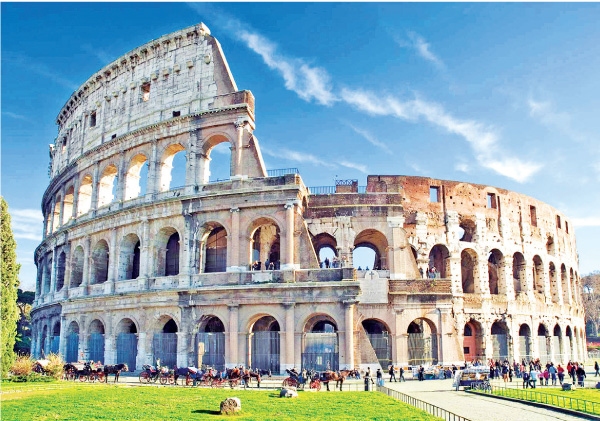
Colosseum
The Colosseum is a huge amphitheatre shaped like an oval. Construction work on the Colosseum began around 2000 years ago during the reign of Emperor Vespasian and was completed by his son Titus. The word Colosseum means “very, very large.” The name Colosseum comes from a large statue or colossus of the Roman Emperor Nero.
Structure and size
Early amphitheatres were built using wood. However, the Colosseum was built using iron and a high quality marble known as travertine. The Colosseum is shaped like an ellipse, measuring 189 metres (615 feet) long and 156 metres (510 feet) wide. The height of the outer walls is about 47 metres (157 feet).
Exterior and interior
The interior of the Colosseum had an acting area, a platform and rows of seats. The Emperor, men and other important people sat near the acting area while women and the poor occupied the upper rows. The Colosseum could accommodate up to 50,000 spectators at a time. The exterior was adorned with arches, windows and columns built in Greek style.
The first games
The Colosseum was built to amuse the Roman people. The first games held in the great amphitheatre lasted for around 100 days. The Romans mostly loved bullfights, fights between wild animals, theatre shows, and gladiator fights.
Facts:
* The Colosseum had 80 entrances and around 240 arches.
* The Colosseum that we see today is just one-third of the original Colosseum.
* The last gladiatorial fights in the Colosseum took place in 435 AD.
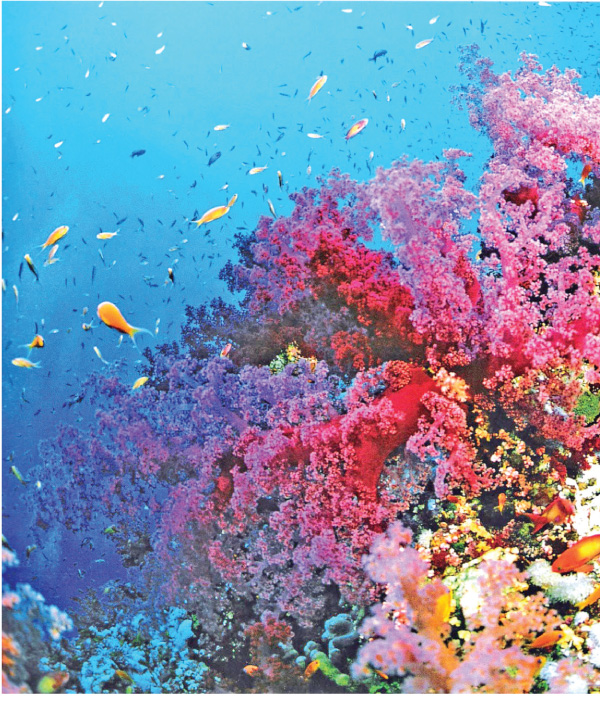
Great Barrier Reef
The Great Barrier Reef is the largest coral reef in the world. It has 3,000 reefs and 600 small islands. The reef stretches for 2,012 kilometres (about 1,250 miles) along the northeastern coast of Australia.
Barrier Reefs
Barrier reefs are reefs formed along the coastline. A wide, deep lagoon separates reefs from the shore. Barrier reefs are called so because they act as a barrier between the ocean and shore.
The Coral
Corals are marine animals. They belong to the family of sea anemones and jellyfish. They have a soft, cylindrical body known as polyp. Coral polyps attach themselves to rocky bottoms in the sea and start multiplying. They build limestone shelters in which they live. These shelters form a large coral.
Marine life
The Great Barrier Reef is home to many species of sea animals and birds. Many endangered species of animals, such as whales, dolphins and sea turtles are found here. It is also home to 29 species of seabirds, 1,500 species of fish and 4,000 species of mollusks.
Facts:
*The Great Barrier Reef Marine Park is larger than UK and Ireland combined.
* The Great Barrier Reef is the only living natural group visible from the Earth’s orbit.
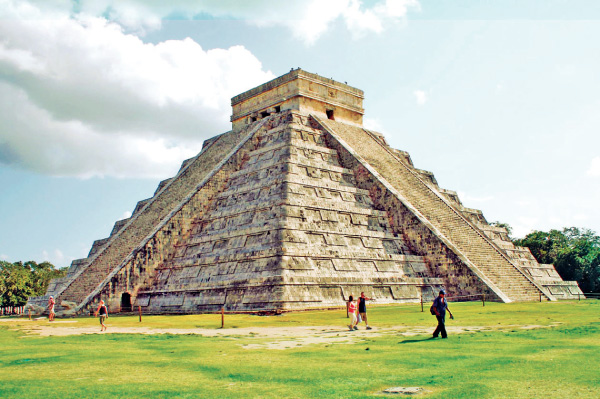
Pyramid at Chichen Itza
The Pyramid of Chichen Itza was built by the ancient Mayan people. They used it as a temple. The Pyramid is known as ‘El Castillo.’ ‘El Castillo’ in Spanish means ‘the castle.’ It was built between 550 AD and 800 AD in Mexico.
Structure
The Pyramid is 23-metres (about 75 feet) high with a square base. The four sides of the base have nine platforms. Over these nine platforms, there are four staircases. Each staircase has 91 steps. On adding all the steps together, along with the one at the top of the temple, there are 365 steps. Each step represents a day of the solar year, which means the staircase served as a calendar.
Village life
Mayan people had small families. They lived together in tiny villages. Their huts were made of interwoven wooden poles and thatched roofs. They used their huts only for sleeping. Cooking was done outside their huts in a common open area.
The City of Chichen Itza
Chichen Itza means ‘at the mouth of the well of the Itza.’ The city of Chichen Itza was built near wells. As water was scarce in that area, people settled near wells which provided water for agriculture and drinking purposes.
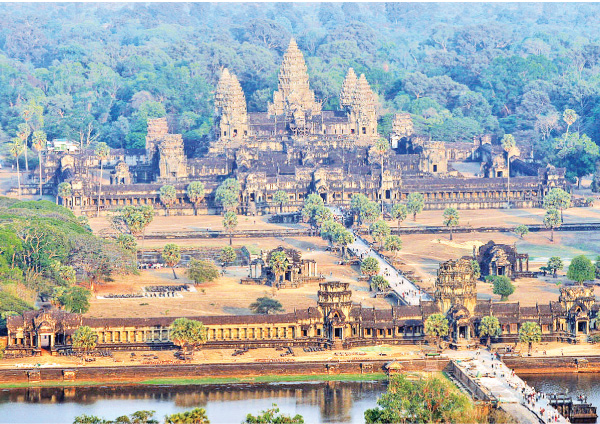
Angkor Wat
Angkor Wat is the largest religious temple complex in the world. It was built in the 12th century AD for King Suryavarman II of the Khmer Empire. Angkor Wat is located in the city of Angkor, Cambodia.
Longest Bas-Relief
Angkor Wat has the longest bas-relief carving in the world. The bas-relief is 800 metres (about 2,625 feet) long and 2 metres (about 7 feet) height. Bas-relief carvings are sculptures that project out slightly from the walls on which they are carved.
The ‘Temple City’
Angkor Wat means the ‘temple city.’ It includes temples, palaces and buildings of the Khmer people. The temple of Angkor Wat has five carved towers that look like pyramids from a distance.
Materials used
Angkor Wat was built from sandstone and laterite (a red soil produced by rock decay). Sandstone was transported from a nearby hill by river. Hundreds of workers, artisans and slaves worked for 30 years to build this huge temple city.
Facts:
*The national flag of Cambodia has a small picture of Angkor Wat.
* Angkor Wat also served as a tomb of Suryavarman II.
*Stories from great epics such as Ramayana and
Mahabharata are also described in the bas-relief.
*Angkor Wat is a significant religious centre of the Buddhists.

Grand Canyon
The Grand Canyon is one of the natural wonders of the world. It is a deep, wide and steep-walled canyon formed by the Colorado River. It includes many canyons and is in Arizona, United States. The Grand Canyon was first explored in 1540 by a Spanish explorer, Garcia Lopez de Cardenas.
The Two Rims
The Grand Canyon has two rims – the North Rim and the South Rim. The North Rim is formed by the Kaibab Plateau, while the South Rim is formed by the Coconino Plateau. The North Rim is about 365 metres (1200 feet) higher than the South Rim.
Colourful Landscapes
The Grand Canyon is one of the most beautiful canyons in the world. It is famous for its colourful landscapes.
Colorado River
The Colorado River is 2,330 kilometres (about 1450 miles) long and flows from the Rocky Mountains. The Colorado River took six million years to form the Grand Canyon. The river looks red because of the volcanic remains and deposits.
Facts
*In the Grand Canyon, around 50 different kinds of reptiles
and 300 species of birds are found.
* The oldest fossils found here are around 12,000 years old.
* The Grand Canyon is spread across three of North America’s
four deserts.
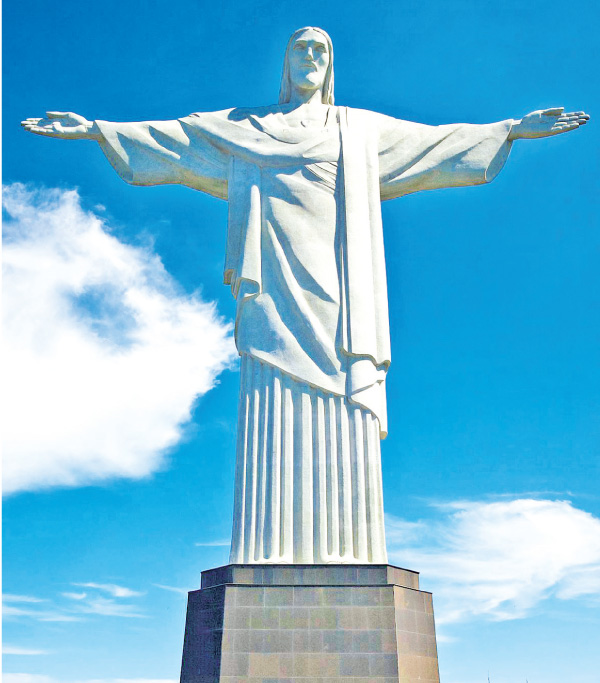
Christ the Redeemer
Christ, the Redeemer is a statue of Jesus Christ. It is one of the biggest statues in the world. It is on the top of Corcovado Mountain in Rio de Janeiro, the former capital of Brazil. Construction work on the statue began in 1922 and was completed in 1931.
The Structure
Christ, the Redeemer is one of the best monuments built in the world. It is made of reinforced concrete and soapstone so that it can remain firmly seated on the ground, even in bad weather. The statue weighs about 1,145 tons.
The Statue
The statue of Christ, the Redeemer was built to celebrate Brazil’s one hundred years of freedom from Portuguese rule. The statue is 39 metres (about 130 feet) high and can be seen from any part of Riode Janeiro. The open arms of Christ are 30 metres (about 98 feet) long from one fingertip to another. Each arm weighs 57 tons.
The Design
The first design of the statue was created by Carlos Oswaldo. It showed Christ holding a globe in one hand and a cross in another. However, it was rejected. Later, a Brazilian designer, Heitor da Silva Costa, designed the present statue. His design showed Christ with wide-open arms ready to embrace people.
Facts:
*Christ the Redeemer was declared a Catholic Sanctuary in 2006 by the Roman Catholic Church.
*The head of Christ was made by joining 50 pieces.
* The monument was green originally, but now it looks gray due to pollution.
* The statue looks like a cross.
